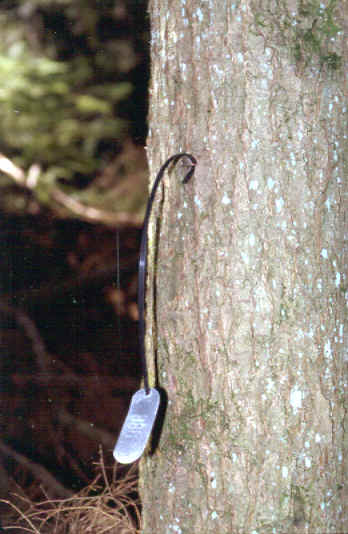Attaching Tree TagsFor as long as foresters have been establishing and monitoring growth and yield plots they have been permanently tagging or numbering individual trees and marking a diameter measurement reference point. Traditionally this has done by painting or nailing numbers on trees. Paint provides very visible numbers (even at a distance) but is messy, must be redone periodically in order remain legible as the tree grows and the paint fades and is not feasible for small trees. Attaching tree tags with aluminum nails has been widely used for many years. However, on fast growing trees, nails must be pulled out frequently to prevent them from being overgrown. On small trees, nails can be difficult to use, can cause stem deformities and can interfere with measurements. Also, even with aluminum nails, some landowners require all nails to be pulled before trees are harvested.
To use cable ties, also known by the brand name Bar-Lok, the cable is run through the hole in the tree tag (the tag is held at the one end of the cable by the lock). The cable is then attached to trees with a staple (often at breast height). A large staple (9/16 inch) is often used and must reach the wood to secure the cable. One staple is used and is attached horizontally about a half-inch from the end of the cable with the long end of the cable and tag (against the lock) dangling over the staple. As the tree grows, it heals over the staple and grows over and straightens the cable. To allow for proper healing, only a single staple should be used in a horizontal rather than vertical direction. Also, one should staple across the cable and not through it. Once attached, the tree will grow over the cable tie eliminating the need to periodically reattach or pull them. They can also be attached to small trees and if properly installed do not cause stem deformities so they can also be used to mark the diameter measurement height. At the time of harvest, because they are plastic there is no danger to sawyers. The cable ties must be stapled into wood so they do not work well for thick bark trees where nails (or paint) are still the best bet. Some animals, especially elk (we donít have much experience with bears), enjoy playing with the dangling tags and can easily pop the tags off the cable. The most common cable length used is 11-inches. For best results, black-UV stabilized cables should be used. These are more expensive, but will last. Specification sheets for the cable ties generally say that they are good for temperatures between Ė40oF and 185oF. We do not know of any advantages between the solid or ladder style of ties. Cable ties are widely available from most supply companies, but one place you can get cable ties is Port Plastics: 7500 SW Tech Center Drive #100
The cost will be about $40.00 for a bundle of 1000 UV stabilized ties. Until we figure out how to in bed chips into trees (it is being worked on), we will have to attach tree identifiers to the outside of the tree. Using cable ties is a quick and easy way to do this that requires little maintenance. |
 Another
option for attaching tree tags is by using cable ties (See figure). This
method has been used for a number of years in the Pacific Northwest. We
believe that researchers at Weyerhaeuser were the first to use cable ties
in this way. The Stand Management Cooperative has used cable ties on its
young stand growth and yield plots through out Oregon and Washington since
mid-1980ís.
Another
option for attaching tree tags is by using cable ties (See figure). This
method has been used for a number of years in the Pacific Northwest. We
believe that researchers at Weyerhaeuser were the first to use cable ties
in this way. The Stand Management Cooperative has used cable ties on its
young stand growth and yield plots through out Oregon and Washington since
mid-1980ís.